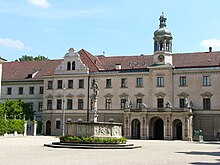Imperial Abbey of St. Emmeram Reichsabtei Sankt Emmeram (German) | |||||||||
|---|---|---|---|---|---|---|---|---|---|
| 1295–1803 | |||||||||
| Status | Imperial abbey | ||||||||
| Capital | St. Emmeram's Abbey | ||||||||
| Government | Theocracy | ||||||||
| Historical era | Middle Ages | ||||||||
• Abbey founded | c. 739 | ||||||||
975 1295 | |||||||||
• Gained Reichsfreiheit | 1295 | ||||||||
1731 | |||||||||
| 1803 | |||||||||
January 6, 1806 | |||||||||
| |||||||||
| Today part of | Germany | ||||||||



Saint Emmeram's Abbey (German: Kloster Sankt Emmeram or Reichsabtei Sankt Emmeram) was a Benedictine monastery founded around 739 at Regensburg in Bavaria (modern-day southeastern Germany) at the grave of the itinerant Frankish bishop Saint Emmeram.[1] The original abbey church is now a parish church named St. Emmeram's Basilica. The other buildings on the site form a large complex known as Schloss Thurn und Taxis or Schloss St. Emmeram, which has served as the main residence of the Thurn und Taxis princely family since the early 19th century.
- ^ Sankt Emmeram is sometimes referred to as Sankt Emmeran
